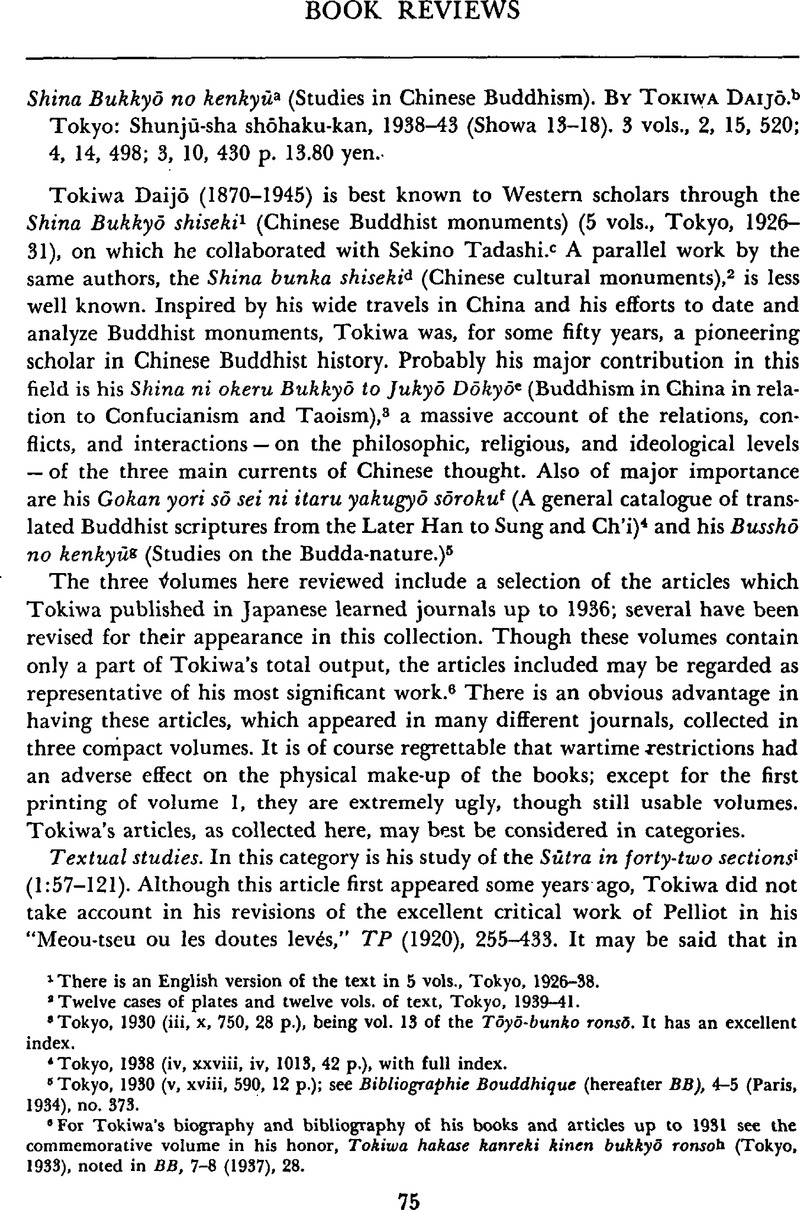No CrossRef data available.
Published online by Cambridge University Press: 23 March 2011

1 There is an English version of the text in 5 vols., Tokyo, 1926–38.
2 Twelve cases of plates and twelve vols. of text, Tokyo, 1939–41.
3 Tokyo, 1930 (iii, x, 750, 28 p.), being vol. 13 of the Tōyō-bunko ronsō. It has an excellent index.
4 Tokyo, 1938 (iv, xxviii, iv, 1013, 42 p.), with full index.
5 Tokyo, 1930 (v, xviii, 590, 12 p.); see Bibliographic Bouddhique (hereafter BB), 4–5 (Paris, 1934), no. 373.
6 For Tokiwa's biography and bibliography of his books and articles up to 1931 see the commemorative volume in his honor, Tokiwa hakase kanreki kinen bukkyō ronsoh (Tokyo, 1933)Google Scholar, noted in BB, 7–8 (1937), 28.
7 See the précis in BB, 7–8 (1937), 509. See characters for Hui-neng in the glossary of Chinese names in K. S. Latourette, The Chinese, vol. 2. Characters found there are not given in this article.
8 See Maspero in BEFEO, 10 (1910), 95–130.CrossRefGoogle Scholar
9 See, for example, Tsukamoto's Shina Bukkyōshi kenkyū Hokugihen (Kyoto, 1942), 10–56Google Scholar, and Miyagawa's Rikuchō shūkyōshi (History of religion in the Six dynasties) (Tokyo, 1948).Google Scholar
10 See Tōhō gakuhō, 16 (Kyoto, 1948), 29–101.Google Scholar
11 BB, 2 (1931), 193.
12 BB, 7–8 (1937), 366–67.
13 Yi-liang, Chou, “Tantrism in China,” HJAS, 8 (1945), 331–32.Google Scholar
14 A basic work dealing with Shan-tao, Fa-chao,ao and the development of this sect is Tsukamoto Zenryū, Tō chūki no Jōdokyōap (Pure Land Buddhism of the mid-T'ang) (Kyoto, 1933); noted in BB, 7–8 (1937), 507.
15 See BB, 3 (1933), 467.
16 See Hayashiya's Kyōrohu kenkyūzt (Study of the catalogues of canonical works) (Tokyo, 1941) and Mizuno Seiichi and Nagahiro Toshio, Ryumon sekkutsu no kenkyu (A study of the Buddhist cave-temples at Lung-men) (Tokyo 1941). The latter was reviewed by A. F. Wright in HJAS, 7 (1943), 261–66. For some of Tsukamoto's works, see notes 9, 10, 14 above. He also contributed the historical chapters of the work on Lung-men. Demiéville says of him (BB, 7–8 [1937], 509) “…un jeune historien (né en 1898) dont l'horizon élargi et les precédés assouplis sont charactéristiques de la nouvelle génération japonaise.”
17 This trend is discernible in the excellent periodical Shina Bukkyō shigakuzu (vols. 1–7, Kyoto, 1937–44); see also monographs 1–10 of the Bukkyō hōsei keiiai kenkyūjō (Institute for the Study of Buddhist Law, Government, and Economics), Tokyo, 1933–34.
18 Part 7 of the history and biography section of the Kokuyaku issaikyōw (The Buddhist canon in Japanese translation) (Tokyo, 1936); see the review in Wei-miao-sheng yüeh-k'an,ax 1, no. 8 (Shanghai, 1937), 26–28.